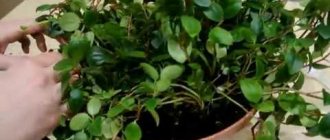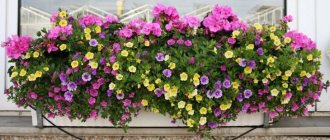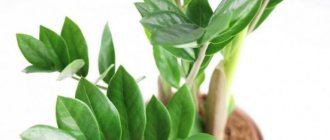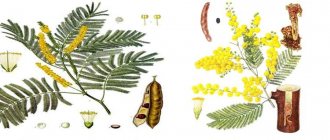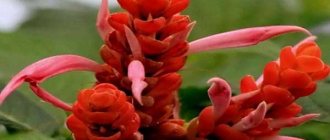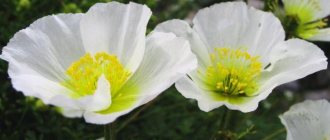Monstera in nature - description of the plant
Monstera is a large tropical plant, an evergreen liana, of the Araceae family. Its native habitat is the equatorial part of America, or more precisely, Brazil and Mexico. Later it was brought to India and successfully settled there.
Monstera can grow up to 20 meters in length, clinging to trees. Along the entire trunk of the vine you can see descending aerial roots. Monstera leaves are large, up to 90 centimeters, often pinnately dissected and perforated. Monstera blooms with cobs, forming a completely edible berry.
Monstera in nature blooms with large flowers-cobs
It should be noted that some species of monstera have poisonous leaves, so a person who eats a piece of the plant can get a burn to the mucous membrane or poisoning.
The discovery of monstera by Europeans is closely related to the legend of killer plants. In those distant times, people saw skeletons of animals and people in the forests, permeated through and through by the aerial roots of this giant vine. And the imagination painted a picture of how the plant with its tentacles killed all living things, although in fact, the roots grew through the skeletal remains. Perhaps that is why it received the name monstera (monstrum), which means monster in Latin.
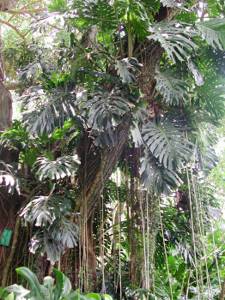
In the tropics, the monstera grows up to 20 meters in height, climbing tree trunks, and to the first Europeans who saw this vine, the aerial roots descending down seemed like scary tentacles
In the 18th century, the plant moved to Europe and began to win the hearts of people and a place in their homes. Then, together with the British colonies, it came to India and spread further to the east.
Now Monstera is my favorite indoor plant. The variety of species allows you to choose a tropical vine of almost any size: for a small room or living room, or for a greenhouse.
To successfully grow in a room, it needs diffused light, high humidity and support for growth.
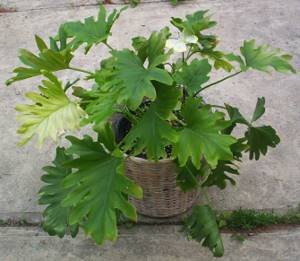
Philodendrons are often confused with Monstera, especially when the plants are young and do not have the characteristic holes on the leaves.
Very often in stores they sell us monstera as philodendron and vice versa. Indeed, young plants are very difficult to distinguish from each other, and until 1763 it was one genus Philodendron. Both species are aroids, both are vines with feathery leaves, they bloom the same, but there is still a difference. When cut, philodendron secretes milky juice of red, orange, yellow color; sometimes the juice is colorless, but when exposed to air it turns brown.
Types and varieties with names
Depending on the room where you want to grow tropical vines, you can purchase different types. The following varieties are well suited for tall and spacious greenhouses: Adanson, oblique, delicacy. For your home, choose more compact vines: delicacy, its variety Monstera Alba, Borziga, thin.
Monstera delicacy. The second name is attractive. The most popular type for indoor growing. When young, its leaves are whole, heart-shaped, but in an adult plant they grow up to 60 cm in diameter and are strongly dissected. In indoor conditions, Monstera deliciosa does not grow higher than three meters, and in greenhouses and in nature - 12 meters. With proper care, it blooms with a large cob, 25 centimeters long and 20 centimeters wide. After pollination, the fruit appears, a berry, which ripens for several months and tastes like pineapple.
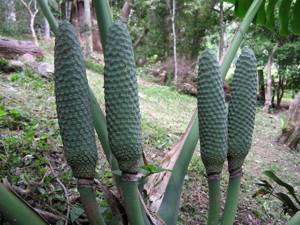
Monstera deliciosa produces edible fruits
Monstera variegate, also known as Monstera Alba. A gourmet variety, but with variegated white leaves. It grows slowly and has increased requirements for light and fertilizing. Sold Dutch specimens often lose their variegation and become ordinary gourmet monsteras.
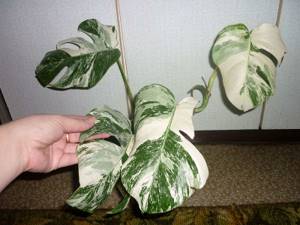
Monstera Alba (variegated) has variegated white-green leaves.
Monstera Borziga. Very common in Mexico, the leaves are medium-sized, pinnate, up to 30 cm in diameter, good for a room. Compared to the delicious monstera, it has thinner stems and grows well. Almost all Dutch plants are of the Borziga variety.
Monstera Adanson (punched, full of holes). An eight-meter vine with ovate leaves 25–55 centimeters long and 20 to 40 centimeters wide. The leaf blade is closed with oval and round holes, unequal, widening towards the petiole. It blooms rarely in a room, with a narrow ear up to 12 centimeters in length.
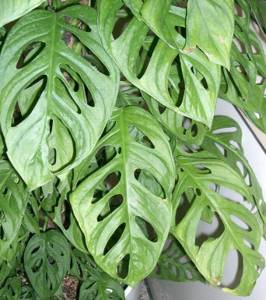
Monstera Adanson has characteristic oval holes on its leaves
Monstera oblique. It also has the following names: Monstera expilata and Monstera crescenta. Inhabitant of the rainforests of Brazil and Guiana. The leaves are oval, long and narrow, which due to the dry air in the room can become very small, causing the plant to take on an unkempt appearance. The best place for growing is in a humid greenhouse. It is there that the internodes become short and the leaves grow up to 25 centimeters in length with a 15-centimeter width.
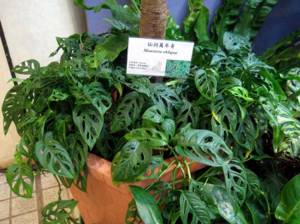
Monstera oblique has long small leaves with oval holes
Monstera is thin. A small liana with openwork leaves. It grows very slowly and even an adult does not exceed 150 centimeters. The leaf unfolds whole, heart-shaped, but over time they become openwork. On one plant at the same time there can be leaves in different stages: both whole and dissected, different in length and width. It looks very impressive, unpretentious, but is rarely found on sale.

Monstera is thin with lacy leaves - quite rare in apartments
Photo gallery - monstera varieties
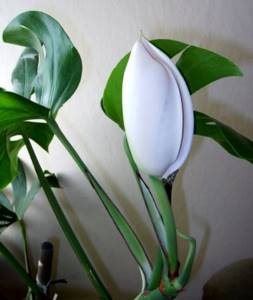
Monstera color - spadix with white veil

Variegated leaves have white parts on the leaf blade
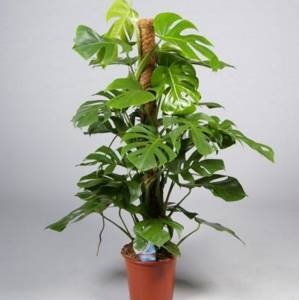
Monstera needs support

When purchasing a monstera, remember that it grows both upward and in breadth. She needs a lot of free space
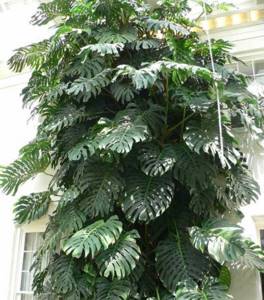
In warm countries you can grow monstera outdoors
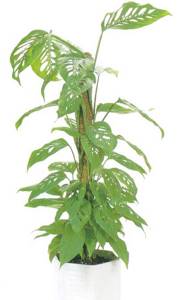
Monstera oblique with its oval holes
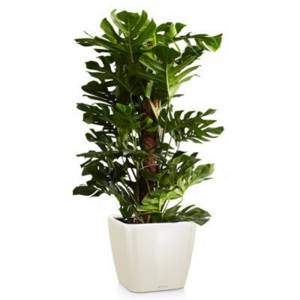
Monstera deliciosa (delicacy) is most common in indoor floriculture

Very rare monstera variegation - yellow leaves
Plant varieties
There are more than fifty species of philodendron in nature. But not all of them are designed for indoor growing. There are several species that can be kept at home:
- Delicious.
- Adanson.
- Oblique or unequal.
- Karvinsky.
- Marble.
- Pointed.
- Punched or seasoned.
- Borziga.
- Doubtful.
- Friedrichstahl.
Despite the fact that breeders have bred many varieties of Monstera, at home the most common color is not variegated, but dark green.
Delicatessen
This species grows quickly, the leaves are shaped like a slightly elongated heart. The height of the flower grows up to 13 meters, in a room - up to three meters. The stems grow 8 cm in diameter. The fruit of the plant is edible and tastes like pineapple. That's why it has such a name. If the conditions in the room are favorable, the Monstera will bloom.

Housekeeping conditions - table
| Parameter | Spring Summer | Autumn winter |
| Temperature | Up to 28 degrees Celsius | Preferably up to 20 degrees |
| Humidity | Requires constant spraying | |
| Lighting | North, east, west window or in the back of the room with a south window | |
| Watering | Frequently, keeping the soil moist | Moderate, especially at low temperatures |
Since the homeland of the vine is the humid tropics, for successful cultivation and maximum decorativeness you need to create just such conditions: humidity, diffused light and warmth, and then with proper care the monstera will live with you for several decades.
Planting and replanting monstera
It is not always possible to take a monstera shoot from friends, then you have to buy it in a store. Instances can be different: from small, recently rooted cuttings to mature plants of 2 meters. Therefore, replanting a monstera after purchase should be approached individually.
Young plants develop very quickly, depleting the entire volume of soil in just a year, so every spring they have to be replanted and the pot replaced with a larger one.
Adult plants are replanted once every 2–3 years, and every spring the top layer of soil, which can be easily removed by hand, is changed.

It is very difficult to replant adult plants that have grown to the ceiling.
Huge vines near the ceiling are usually planted in large flowerpots and tubs, so it is not easy to replant them even once every 5 years. But often such old monsteras become ugly due to the exposed stem, the presence of a large number of aerial roots and a few leaves at the top. In this case, the monstera should be rejuvenated: cut off the entire above-ground part, cut into cuttings so that each piece has an aerial root, and immediately plant in separate containers.
Pot
The choice of pot size and material depends on the plant. The larger the monstera, the larger, and preferably heavier, container for planting is chosen. Therefore, they often use clay or wood rather than plastic ones. For a small cutting with two to three leaves, use a pot with a volume of at least five liters, and for adult gourmet monsteras about 15–20 liters. It is important not to plant a small cutting immediately into a large pot, as the soil may become acidic.

The monstera pot is selected taking into account the size of the plant
Priming
Use nutrient soil with a slightly acidic reaction; you can prepare it as follows:
- 2 parts turf soil, 1 part peat, 1 part vermicompost or compost, 1 part river pebbles or small expanded clay, 1 part pine bark
- 2 parts turf soil, 1 part leaf humus, 1 part vermicompost, 1 part vermiculite, 1 part coconut substrate
- 2 parts of ready-made commercial soil for palm trees or philodendrons, 1 part vermicompost, 1 part vermiculite, 1 part coconut fiber or pine bark
If you decide to use sand, be sure to use coarse sand.
The finished soil must be porous and nutritious.
How to transplant an adult plant
When replanting a plant and replacing the soil, you should proceed in the following sequence:
- We water the monstera half an hour before transplanting.
- Select the pot of the right size.
- We pour 4-5 centimeters of drainage - expanded clay - onto the bottom.
- Carefully insert a scoop between the soil and the wall and remove the roots. If the pot is made of soft plastic, then the walls can be dented.

The correct sequence for replanting a houseplant
- We turn the monstera pot on its side and pull out a lump of earth, holding the plant.
- Carefully shake off the old soil onto an oilcloth previously laid on the floor or table.
- You can wash the roots in a bucket of water.
- Pour a small layer of pre-prepared soil into a new pot and place the monstera so that the roots touch the soil. We constantly support the plant with our hands and do not let go.

Place the plant in a pot and carefully cover it with soil.
- We fill it with fresh soil, pressing it lightly.
- We water the monstera and add soil again where the soil has settled.
It is better to transplant an adult plant with a large earthen ball together.
Video - transplanting into a larger pot
Monstera in the interior
It is very important to understand that from a small compact bush sold in a store a huge heavy vine will grow, and it grows both upward and in width. Often, to reduce the amount of space taken up, supports are placed on it.
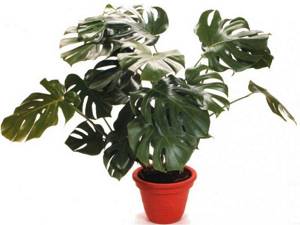
Everyone wants to have such a compact monstera bush, but it grows quickly and stretches out
In nature, the monstera climbs up trees; there is no point in placing tree branches in rooms; it is better to use special tubes wrapped in coconut fiber.
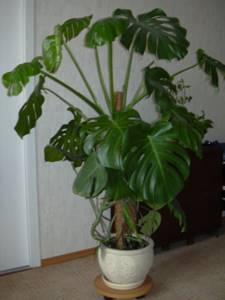
Most often, the monstera is tied to supports covered with coconut fiber.
But the best option is to make your own support from a plastic pipe with a cross-section of 2–3 cm. A thick layer of sphagnum moss is wrapped around it, which perfectly retains moisture and will be an additional source of water for the monstera’s aerial roots.
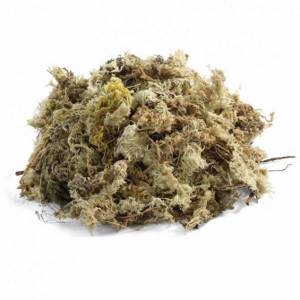
Sphagnum moss is an excellent filling for homemade supports.
A layer of plastic coarse mesh 1*1 cm is wrapped around a stick with moss and secured with wire or fishing line.
You can make a support from a large-diameter plastic pipe, drill many holes on the side for roots, and pour moss inside the stick. For good stability, this support should be installed on a cross and secured in the pot before planting the plant.
Monstera is often installed on stands, placed on a table or cabinets.
Photo gallery - plant in the interior

Large specimens are best placed on a stand with wheels.

Monstera needs strong support
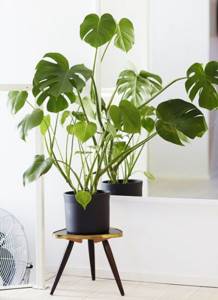
It is better to place the monstera in a well-lit place
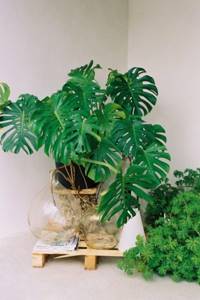
It is better to place the aerial roots of the plant in a jar of water for additional nutrition.
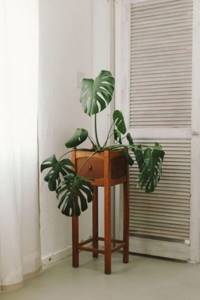
The original wooden stand can be used
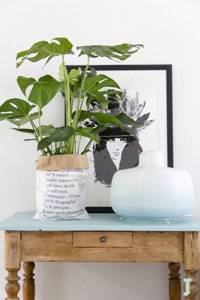
small monsteras are often placed on the table
Flowering Monstera
In its natural environment, Monstera blooms in large inflorescences. They reach 30 cm in size and can be cream or yellowish in color. The structure of the inflorescence is simple: inside there is an ear, which looks like a head of corn, and on the outside it is covered with a petal. The inner ear of the Delicious Monstera is edible. It tastes like pineapple.
In captivity, the plant does not bear fruit and blooms rarely, as it needs more humidified air. Yes, and fertilizing is intended for the formation and growth of green mass, and not for flowering. But a plant without a flower looks no worse.
How to care for monstera at home
Monstera is quite unpretentious in care; only variegated forms require improved conditions.
Watering and fertilizing
Despite the fact that Monstera loves high humidity, it should not be watered often. The soil in the pot should dry out on top. Due to the slight waxy coating, the leaves do not evaporate much moisture. When wintering monsters on an insulated balcony, it is watered after most of the earthen clod has dried out.
It is advisable to use warm, settled or rain water.
When young plants are transplanted annually into fertile soil, the monstera does not need to be fed, but adult plants, whose soil does not change, are in great need of mineral and organic substances. Use liquid organic and mineral fertilizers 2 times a month in the warm season.
Recent Entries
5 working ways to use tar in the garden 7 indoor plants that help you get married even in adulthood Indoor plants that can bloom in trouble

In the warm season, monstera should be fed with liquid fertilizers.
Very large old plants are additionally sprayed with fertilizer on the leaf, diluting them in accordance with the directions on the label.
In winter, you can continue to feed the monstera only if it is kept in a warm room and there is enough light for it; the new leaves are as large as the summer ones. If the leaves become smaller and lighter, the plant should be moved closer to the light source or illuminated with lamps.
Bloom
Most often, Monstera deliciosa blooms in rooms. But for this it is necessary to create optimal conditions for growth.
The monstera flower is a spadix with a white or cream pericarp.

Monstera flower with buds
After flowering, the flower's cover falls off and the spadix turns green. It matures in 8 to 10 months. In exotic countries, the fruits of Monstera deliciosa are sold in local markets.
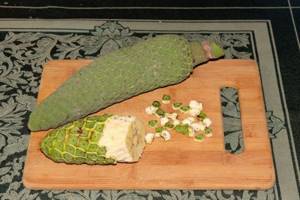
The delicious Monstera fruit is edible and tastes like pineapple.
Eating an unripe fruit is very dangerous, as you can get poisoned, and the ripe berry of an exotic vine tastes like pineapple. It is also advisable to eat it with a fork, pricking individual kernels, like an ear of ordinary corn.

Monstera fruit can be eaten like corn
The monstera fruit will tell you about its ripeness: the green scales will fall off.
Rest period
In the wild, monstera does not have a specific dormant period. However, in apartments, especially in the northern parts of the country, where daylight hours sharply shorten in autumn and winter and the brightness of the sun decreases, the temperature at which the monstera is kept should be reduced. It is optimal to keep it at 18–20 degrees, while reducing the number of waterings. This is done so that new leaves do not appear too often and do not stretch out, because with a lack of lighting they become smaller and the internodes increase. If you have a sunny winter or the monstera is in a greenhouse, where the same temperature and day length are maintained all year round, then care in winter is no different from summer.
Crown formation
It is not possible to get a lush monstera bush from one shoot. It stubbornly grows upward and if there is no support, it spreads along the surface. If the vine has grown and the lower part of the stem is bare, then you can cut off the crown with the aerial root and root it, and the remaining trunk can produce new side shoots.
If you plant several monstera cuttings in one pot at once, a more lush vine will grow than usual. But she also needs support and a guiding garter.
In nature, Monstera clings to trees with aerial roots and leaf cuttings. In addition, aerial roots absorb moisture from the air and additionally nourish the vine, and when they reach the ground, they grow into it.
In rooms, it is recommended to tie aerial roots with damp moss or direct them into a support with soil (if one was used) or into a bottle of water.

The aerial roots of Meonstera cannot be cut off.
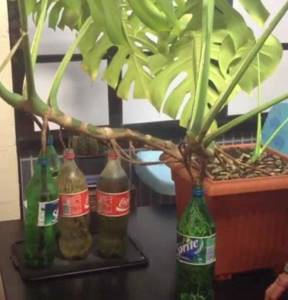
You can put them in water bottles, but it's not aesthetically pleasing.
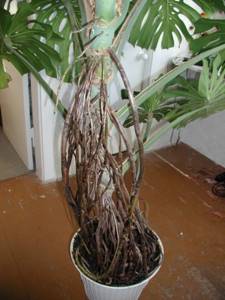
Monstera aerial roots are directed into a pot
Never trim aerial roots.
Errors in caring for Monstera - table
The most common maintenance mistakes lead to the appearance of whole sheets, their shredding, and yellowing.
| Sign | Problem | Treatment |
| Small leaves, no slots | Lack of light | Newly opened leaves are always whole, but if, over time, slits and holes do not appear on them, move the monstera to a brighter place. |
| Massive yellowing of leaves with simultaneous loss of turgor (elasticity) | Overwatering, possible root rot | Loosen the plant and move it to a warm room in winter. When the stems wilt, the crown and branches should be re-rooted. |
| Gradual yellowing of leaves from the tip | Lack of nutrition | Feed with liquid fertilizers. |
| Yellowing of leaves and appearance of dry patches, | Overdrying the earthen coma | Touch the soil in the pot. If it is very dry, you should increase the frequency of watering. |
| Brown spots along the entire leaf edge of older plants | Potassium deficiency | Replant the plant or feed it with potassium fertilizers. |
| Transparent leaves subsequently turn brown | Sunburn | Protect from direct sunlight. |
| Monstera does not grow, leaves fall off | Lack of light | Often found in winter near northern windows. Move to another lighter window or add additional lighting with lamps. |
| Leaves turn brown and look papery | Lack of moisture in the air | Spray the plants more often or install a humidifier. |
| "Crying" leaves | Overflow, excess moisture in the air | Droplets of water accumulate at the tips of the leaves in cloudy weather before rain, as well as after heavy watering. |
| Variegation disappears | Lack of light | Monsteras with a white-green color may have purely green leaves due to lack of light, so such varieties are placed only in a well-lit place. |
Possible problems
Problems when growing vines rarely arise. They are mainly associated with a deficiency or excess of nutrients in the soil and improperly organized watering.
Leaves fall
If you care for the monstera properly, no problems will arise. But it often happens that the leaves of the plant still fall off. The cause may be a lack of sunlight. If the vine is in the shade all the time, it will begin to lose its foliage. In this case, you can simply move the pot to the sun, to the west or east side.

Spots on the foliage
Spots on foliage are caused by spider mites. Spots can also occur due to lack of sunlight.
Yellowing of leaves
Foliage can turn yellow for various reasons:
- Overmoistening of the soil (in this case, the leaves also begin to rot).
- Lack of nutrients in the soil.
If the leaves become pale yellow and covered with yellow spots, this indicates an excess of sunlight.
Brown foliage
The foliage turns brown due to too dry air. The reason may also be that the plant is cramped in the pot. Or it may be that the soil is constantly waterlogged.
In this case, the leaves will not only turn brown, but also rot.
Pale color of young platinum leaves
Young leaves may turn pale due to lack of sunlight. It could also be due to a lack of nutrients.
The bush stretches out
The bush stretches out if it does not have enough sunlight. This usually happens if the vine stands in the shade all day. You can solve the problem if you place the pot in the sun for a while, and then move it to partial shade, where there will be diffused light.
Whole foliage
If the foliage is solid on young leaves, there is nothing terrible about it; divisions appear later. If the mature foliage is whole, this may indicate a lack of sunlight, low air temperature, or a lack of moisture or nutrients.

The foliage dries up and flies away
Old leaves usually fall off. If several leaves fall off at once and the top leaves turn brown, this may indicate that the room is too hot.
Monstera diseases and pests - table
| Pest | Description | Treatment |
| Shchitovka | Small brown insects, round in shape, shield-shaped, resembling 1–2 mm growths on leaves and stems. A leaf affected by scale insects turns pale and dries out. | The leaves are wiped with a soapy sponge, and pests are removed by picking them up with a needle. In case of severe damage, make a solution of actara (8 grams per 10 liters of water) and spray the monstera. |
| Trips | A small insect 1–2 mm in length, thin, jumps very well and lives in small groups. A leaf affected by thrips is covered with silvery translucent spots, and black excrement is visible on the reverse side. | Use fitoverm, actara, decis. Dilute according to the instructions and carry out at least 2 sprays every 5-7 days. |
| Spider mite | A small spider that weaves a web around the internodes and sucks the juices from the plant. The leaf is covered with small yellow spots. | If the damage is small and the size of the plant is small, it is better to take baths with soapy water (covering the soil from soap); a large plant is usually treated with anti-mite drugs: Apollo, Anti-mite, Vermitek. |
| Mealybug | Furry white bugs that accumulate en masse on leaf petioles look very similar to cotton wool. The leaves become distorted and the plant withers. | The scale insects are removed with a cotton swab or a disk soaked in alcohol, and the plant is treated with Aktara. |
Monstera is practically not affected by diseases. The main reasons for the deterioration of the plant’s condition are associated with improper care: dry air and soil, lack of light or excess moisture. With good care, the monstera does not get sick, but pests do not bypass it.
Photo gallery - diseases and pests, care errors

A mealybug on a plant looks like white cotton wool. A leaf damaged by spider mites.
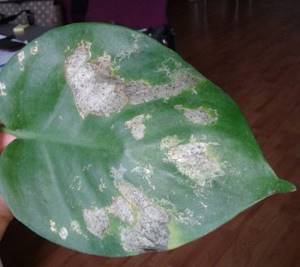
Monstera leaf damaged by thrips
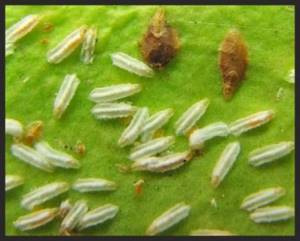
Remove the scale with a needle and wipe the leaf with soapy water.
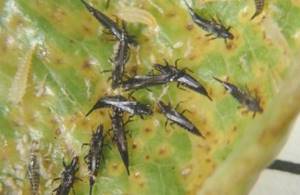
It is better to immediately spray thrips with phytoverm
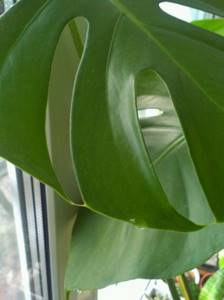
If it rains outside, the monsters in the room may cry - this is how the plant gets rid of excess moisture
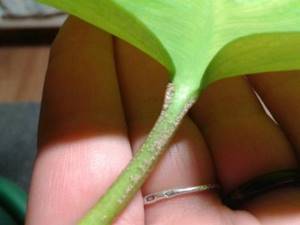
Monstera leaves are often covered with such a corky coating - this is quite normal.
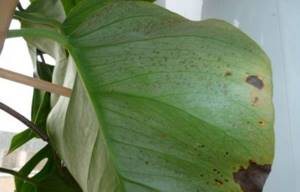
Dark spots on the leaf and on the edge indicate dry air and uneven watering
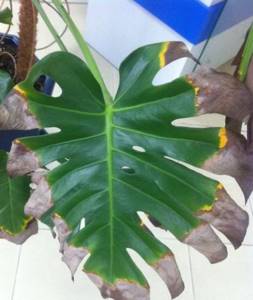
If the monstera is often overdried, the leaf turns yellow and then dries out.
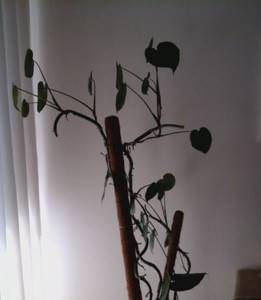
With a lack of light, the leaves become smaller, the monstera does not grow
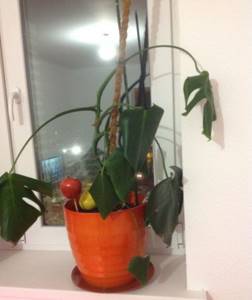
If there is insufficient watering, the leaves often wither, but sometimes the roots can rot in cold and wet soil.
Myths and truth about indoor flowers
You may be interested in: Favorable days for planting Ageratum seedlings in 2021 according to the lunar calendar Favorable days for sowing snapdragon seedlings in 2021 according to the lunar sowing calendar Favorable days for sowing lobelia in 2021 according to the lunar sowing calendar
The Monstera plant evokes mixed feelings. After all, there are some myths that do not speak in his favor. The name comes from the Latin word for “monster” or “beast”. Back in the 18th century, when they explored Latin America, Europeans saw human skeletons that were entangled and riddled with the vines and roots of this flower. Therefore, people decided that this plant attacks people and animals and kills them. But the fact is that the stems can easily grow through any obstacle.
But there is a version that the flower received its name from another Latin word “amazing”. Monstera has a positive effect on the indoor atmosphere and climate. During the daytime, green leaves release a lot of oxygen and humidify the air due to the evaporation of moisture in the leaf surface.
In addition, the vine absorbs harmful electromagnetic waves and disinfects the air in the room. Due to this, people get sick less. Some even believe in her help on an energetic level. For example, with its help you can easily concentrate on work, calm down or relax.
On a note!
You cannot place a flower in a room where people sleep. After all, it is at night that photosynthesis stops, as a result of which the plant absorbs a lot of oxygen.
In other cases, Monstera creates only comfort and harmony. It makes the room comfortable and does not require special attention.
Reproduction
Monstera gained its popularity not only because of its spectacular appearance, but also because of its simple and easy propagation.
Cuttings
The easiest way to propagate a liana is by cuttings, and it practically does not matter where it is taken from: whether it is the top of the plant with leaves, or part of the stem with one leaf and an aerial root, or a side shoot - the rooting technology is the same:
- Sprinkle the cut of the cutting with crushed coal or lightly dry it.
- A layer of drainage and soil for the monstera are poured into a small pot.
- The apical cuttings are placed vertically in the ground, buried a couple of centimeters, and short stem cuttings with an aerial root and one leaf can be laid flat and secured from displacement with a staple.
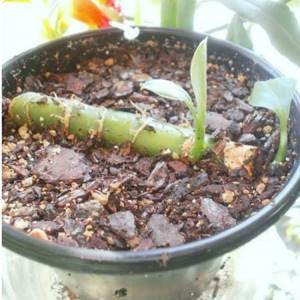
Part of the stem with a bud and an aerial root can be placed horizontally on the ground
- Water the plant and cover with a cap from a transparent bag, creating a humid microclimate inside.
- Place the pot in a warm and bright place, but without direct sunlight.
- Water regularly in the morning and evening with small portions of warm, settled water.
When propagating by apical cuttings that have no roots, it is better to use a glass of water instead of soil, put an activated carbon tablet in it and lower the cutting itself. Only after 3 roots have appeared can it be transplanted to a permanent location.
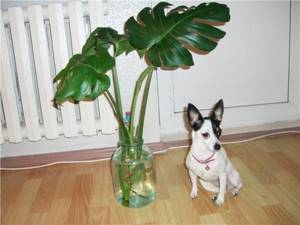
If there are no roots on the cutting, then it is better to root it in a jar of water, placing it in a bright, warm place, but without direct sunlight
Video - planting a monstera cutting rooted in water
Propagating monstera with leaves without a piece of stem often does not give the desired result, but even it can take root if placed in water.
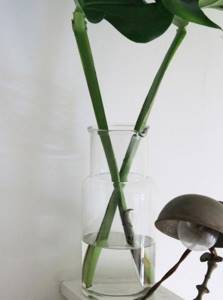
Sometimes even a monstera leaf can give roots
If the monstera has powerful aerial roots, then try to propagate it by layering; to do this, place the selected roots in a bottle of water and wait until they become fibrous. When the roots reach fullness, a cut is made on the stem under the root and the cutting is separated. The cut is sprinkled with coal and the monstera is planted in the ground.

When propagating Monstera by layering, the root mass is first increased, and only then the cutting is cut off from the plant
In any case, the best time for cuttings is spring and early summer.
Growing from seeds
This is a rather long task, but sometimes it is interesting to see how a huge vine grows from a small seed. Then she becomes like a member of the family.
The seeds need to be fresh and are usually not found in stores; it is easier to find them on special websites dedicated to exotic plants.
Sowing is carried out in pots with drainage and soil for monstera. At a temperature of 20–25 degrees, it germinates within a month. During this waiting period, soil and air moisture should be constantly maintained, so it is better to cover the pot with a transparent bag.
In the first six months, the monstera will have juvenile leaves, that is, without cuts and ovals inherent in the planted variety.
Young monsters require the same care as adults: warmth, humidity, diffused light. In 2 years, a vine grown from seeds can grow nine leaves; it will be very hardy and adapted to your conditions.
Video - growing monstera from seeds
To make the monstera look impressive in the interior, you need to choose a beautiful support, periodically wipe the leaves from dust, or you can spray them with special sprays.
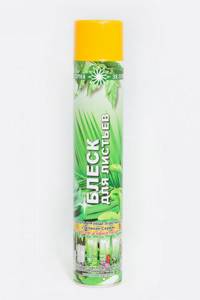
Special sprays for leaves protect them from dust
Remember that she really loves space and it is better to put another indoor flower in a small corner than to push a huge vine.
